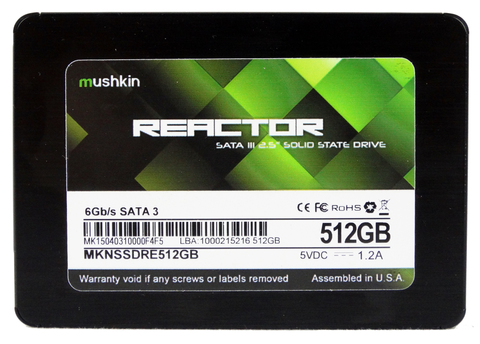Early Verdict
If you just want to get entry level SSD performance and don't want to spend a lot of money, the Reactor 512GB is a good way to get flash in your system.
Pros
- +
Low cost • Acceptable performance • Better than a hard drive • Notebook battery life
Cons
- -
Performance under heavy use and client workloads
Why you can trust Tom's Hardware
Introduction
Mushkin originally released its Reactor at a single capacity point: 1TB. That model is currently our Budget Buy leader. It's an affordable, well-balanced SSD for anyone looking for acceptable performance at a low price.
Like the 1TB Reactor, Mushkin manages to position its newer 512GB model as the lowest-priced SSD in its capacity class on Newegg and Amazon. Nearly every aspect of the Reactor was designed to cut costs. The company even introduced an edge connector able to increase rigidity while shaving 10 to 12 cents from the bill of materials.
The drive uses Silicon Motion's proven SM2246EN controller paired with Micron's low-cost L95B 16nm flash. Mushkin was one of the first companies to utilize the SM2246EN, and we've since seen SanDisk, Crucial and a number of other vendors integrate it into their own budget-oriented products. The processor uses only four channels to the flash, so it's a low-cost part. But Silicon Motion squeezes a lot of performance out of the design. At the same time, it doesn't use much power.
Silicon Motion provides firmware as part of its solution, so companies working with the SM2246EN don't incur a lot of R&D resource drain. After the initial tooling and validation, they can take products to market quickly.
Mushkin now packages flash purchased in wafer form. This allows the company to take in several grades of NAND and use the best dies for solid-state drives. The lower-grade stuff goes into thumb drives and other flash-based products. But the Reactor uses Micron L95B 16nm NAND, which we've found to be faster than Toshiba's 15nm MLC and TLC flash. Micron has been selling L95B to third-party companies for around a year now. Yields are up, so it's plentiful and cheap.
Two other cost-cutting measures are used to make the Reactor more affordable. First, it ships in a blister pack without any accessories. We don't mind this since SSDs are robust and difficult to damage. Second is that previously-mentioned edge connector, designed by parent company Avant Technology.
-
SuperVeloce Those 512 and 1TB are made perfectly for my steam folder, cheap and large. Now we need to wait for someone to launch it to EU marketReply -
jessterman21 Been eying this drive and the BX100 500GB for a few months now - waiting to pull the trigger on whichever's cheaper. The extra latency worries me, but in a gaming/media rig should it really matter? Those two drives are literally the same in all other tests.Reply -
Eggz Cool. This seems like a pretty good option for a gaming computer. I wouldn't use it for a photo editing rig, or any other media-based computer (especially not database oriental computing), but games are pretty easy on drives, and these come in at a decent price while offering plenty of storage space.Reply -
agentbb007 Tough sell considering the 500GB Samsung 850 Evo is $178 on Amazon with free prime shipping and seems to give better performance, unless I'm missing something?Reply -
Saberus Granted it's not the absolute best, but it's not bad, especially at the price. I think the edge connector is a brilliant idea, and wonder why there aren't more companies using it, it eliminates a point of failure where the solder joints were.Reply -
geopirate agentbb007 this drive is $88 for 500gb vs your $178 (less than half the cost) that won't be noticeably slower in a typical usage environment. Is that what you're missing?Reply -
geopirate agentbb007 this drive is $88 for 500gb vs your $178 (less than half the cost) that won't be noticeably slower in a typical usage environment. Is that what you're missing?Reply -
shrapnel_indie Reply16122495 said:I think the edge connector is a brilliant idea, and wonder why there aren't more companies using it, it eliminates a point of failure where the solder joints were.
I guess because in some ways its so old school. (It saved money back then too.) Back in the "Home Computer" days card-edge connectors were used for expansion connections (on one side of the connection.) Retro consoles used it too with game carts. The PC used it then, and even still today, for expansion AND adding graphics. Back in the day Floppy drives, primarily 5.25" and larger used such a connection for data (and a molex for power.)
If that patent ever gets challenged, I dunno if it will hold-up because of all of that. In Modern storage though, the connector is, currently, unique though.


